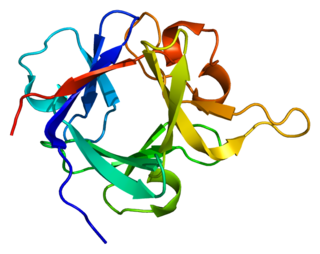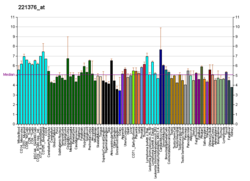
Probable G-protein coupled receptor 162 is a protein that in humans is encoded by the GPR162 gene.

Fibroblast growth factor 8(FGF-8) is a protein that in humans is encoded by the FGF8 gene.

Glia-activating factor is a protein that in humans is encoded by the FGF9 gene.

Fibroblast growth factor 18 (FGF18) is a protein that is encoded by the Fgf18 gene in humans. The protein was first discovered in 1998, when two newly-identified murine genes Fgf17 and Fgf18 were described and confirmed as being closely related by sequence homology to Fgf8. The three proteins were eventually grouped into the FGF8 subfamily, which contains several of the endocrine FGF superfamily members FGF8, FGF17, and FGF18. Subsequent studies identified FGF18's role in promoting chondrogenesis, and an apparent specific activity for the generation of the hyaline cartilage in articular joints.

Fibroblast growth factor-binding protein 1 is a protein that in humans is encoded by the FGFBP1 gene.

Latent-transforming growth factor beta-binding protein 3 is a protein that in humans is encoded by the LTBP3 gene.

Fibroblast growth factor receptor substrate 3 is a protein that in humans is encoded by the FRS3 gene.

Sodium-coupled neutral amino acid transporter 3 is a protein that in humans is encoded by the SLC38A3 gene.

Cdc42 effector protein 1 is a protein that in humans is encoded by the CDC42EP1 gene.

Fibroblast growth factor 14 is a biologically active protein that in humans is encoded by the FGF14 gene.

Fibroblast growth factor receptor-like 1 is a protein that in humans is encoded by the FGFRL1 gene.

Fibroblast growth factor 13 is a protein that in humans is encoded by the FGF13 gene.

Fibroblast growth factor 6 is a protein that in humans is encoded by the FGF6 gene.

Fibroblast growth factor 12 is a protein that in humans is encoded by the FGF12 gene.

Nucleoside diphosphate-linked moiety X motif 6 is a protein that in humans is encoded by the NUDT6 gene.

Tyrosine-protein kinase STYK1 is an enzyme that in humans is encoded by the STYK1 gene.

Chromosome transmission fidelity protein 8 homolog is a protein that in humans is encoded by the CHTF8 gene.

ELL-associated factor 2 is a protein that in humans is encoded by the EAF2 gene. It is part of the EAF family of proteins.

Centrosomal protein of 57 kDa is a protein that in humans is encoded by the CEP57 gene. It is also known as translokin.

Paired mesoderm homeobox protein 2 is a protein that in humans is encoded by the PRRX2 gene.



















